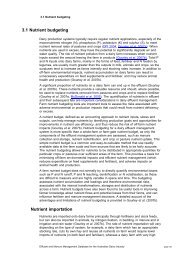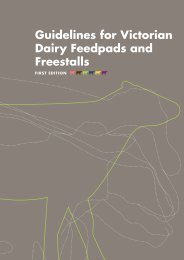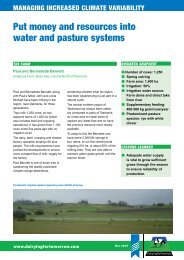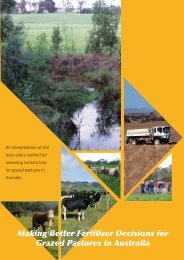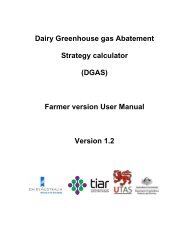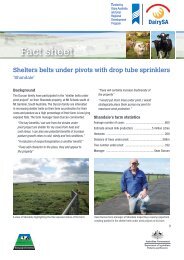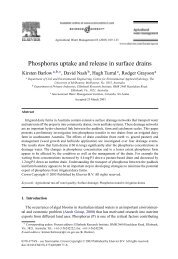Australian Dairy Industry In Focus 2009 - Dairying For Tomorrow
Australian Dairy Industry In Focus 2009 - Dairying For Tomorrow
Australian Dairy Industry In Focus 2009 - Dairying For Tomorrow
Create successful ePaper yourself
Turn your PDF publications into a flip-book with our unique Google optimized e-Paper software.
Cheese<br />
Australia produced 342,000 tonnes<br />
of cheese in 2008/09 – a 5% decrease<br />
on the previous year. While the production<br />
of cheddar, hard grating and mouldripened<br />
cheese types increased on the<br />
previous year – due in part to milk<br />
availability – the production of semi<br />
hard and fresh cheeses declined quite<br />
significantly as Australia’s key export<br />
markets contracted due to the global<br />
economic downturn.<br />
The longer-term trend away from<br />
cheddar cheeses towards non-cheddar<br />
cheese types has been apparent in both<br />
the production and consumption data<br />
for Australia for some years. However,<br />
2008/09 saw a reversal in this trend, with<br />
the non-cheddar share of total production<br />
dropping back from 52% to 48%.<br />
It is estimated that around 55% of the<br />
domestic sales of <strong>Australian</strong> cheese are<br />
through supermarkets. A significant<br />
proportion – mostly specialty cheeses –<br />
is sold through the smaller independent<br />
retail trade, with the remainder used<br />
in the foodservice sector and in food<br />
processing applications.<br />
Cheese is a major product for the<br />
<strong>Australian</strong> dairy industry, with sales<br />
of 205,000 tonnes within Australia, valued<br />
at an estimated A$1.7 billion, and export<br />
sales of 144,650 tonnes, worth more than<br />
A$789 million in 2008/09.<br />
Supermarket sales volumes returned<br />
to growth in the past year, up by nearly<br />
2% in 2008/09, with average retail prices<br />
increasing by 10% during the year.<br />
Cheddar cheese sales grew 1%, while the<br />
non-cheddar cheese types grew by 3%;<br />
continuing a slow but steady trend away<br />
from cheddar. Non-cheddar cheeses now<br />
make up a third of all supermarket sales –<br />
up from a quarter at the start of the decade.<br />
See Appendix 4 for more details<br />
of supermarket cheese sales.<br />
Cheese imports accounted for 22%<br />
of estimated domestic sales last year.<br />
<strong>In</strong> 2008/09, 72% of the 58,800 tonnes<br />
of cheese imported into Australia<br />
was sourced from New Zealand. The<br />
bulk of the remaining cheese imports<br />
came from Europe.<br />
Japan remained Australia’s most important<br />
overseas cheese market in 2008/09 and<br />
accounted for more than 50% of product<br />
exports, followed by the US, China, South<br />
Korea and Saudi Arabia. <strong>Australian</strong><br />
cheeses were exported to more than 65<br />
countries around the world last year.<br />
The trend away from cheddar cheeses<br />
to non-cheddar cheese types evident in the<br />
domestic market is also being reflected<br />
in Australia’s cheese exports; the noncheddar<br />
share of total export sales has<br />
steadily increased from 45% to 54% since<br />
the start of the decade.<br />
Table 14<br />
<strong>Australian</strong> cheese production by type of cheese<br />
2003/04 2004/05 2005/06 2006/07 2007/08 2008/09 (p)<br />
Cheddar 207,795 195,887 191,693 179,159 171,260 178,274<br />
Semi Hard 88,712 90,714 76,813 75,529 73,467 61,700<br />
Hard Grating 11,333 13,267 23,022 18,477 16,922 17,936<br />
Fresh 70,880 83,649 75,441 84,443 90,967 75,194<br />
Mould 5,042 4,833 5,847 6,030 7,968 8,912<br />
Total Cheese 383,762 388,350 372,816 363,638 360,584 342,016<br />
Source: <strong>Dairy</strong> manufacturers<br />
<strong>Australian</strong> <strong>Dairy</strong> <strong><strong>In</strong>dustry</strong> <strong>In</strong> <strong>Focus</strong> <strong>2009</strong> 27



